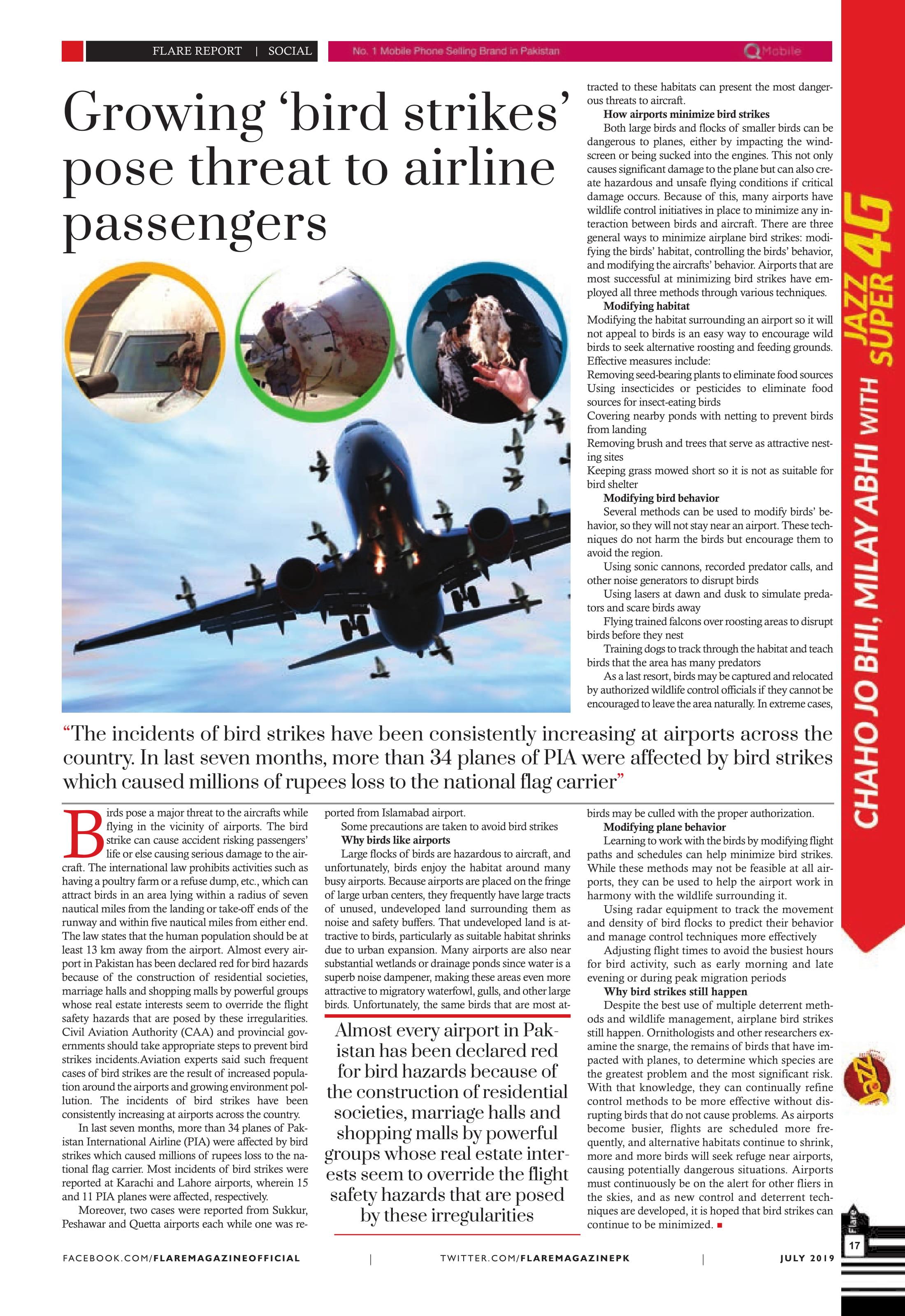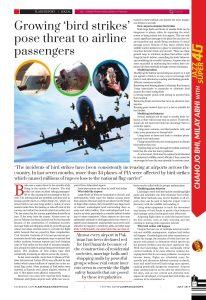
Growing ‘bird strikes’ pose threat to airline passengers
“The incidents of bird strikes have been consistently increasing at airports across the country. In last seven months, more than 34 planes of PIA were affected by bird strikes which caused millions of rupees loss to the national flag carrier”
Almost every airport in Pakistan has been declared red for bird hazards because of the construction of residential societies, marriage halls and shopping malls by powerful groups whose real estate interests seem to override the flight safety hazards that are posed by these irregularities
Birds pose a major threat to the aircrafts while flying in the vicinity of airports. The bird strike can cause accident risking passengers’ life or else causing serious damage to the aircraft. The international law prohibits activities such as having a poultry farm or a refuse dump, etc., which can attract birds in an area lying within a radius of seven nautical miles from the landing or take-off ends of the runway and within five nautical miles from either end. The law states that the human population should be at least 13 km away from the airport. Almost every airport in Pakistan has been declared red for bird hazards because of the construction of residential societies, marriage halls and shopping malls by powerful groups whose real estate interests seem to override the flight safety hazards that are posed by these irregularities. Civil Aviation Authority (CAA) and provincial governments should take appropriate steps to prevent bird strikes incidents.Aviation experts said such frequent cases of bird strikes are the result of increased population around the airports and growing environment pollution. The incidents of bird strikes have been consistently increasing at airports across the country.
In last seven months, more than 34 planes of Pakistan International Airline (PIA) were affected by bird strikes which caused millions of rupees loss to the national flag carrier. Most incidents of bird strikes were reported at Karachi and Lahore airports, wherein 15 and 11 PIA planes were affected, respectively.
Moreover, two cases were reported from Sukkur, Peshawar and Quetta airports each while one was reported from Islamabad airport.
Some precautions are taken to avoid bird strikes
Why birds like airports
Large flocks of birds are hazardous to aircraft, and unfortunately, birds enjoy the habitat around many busy airports. Because airports are placed on the fringe of large urban centers, they frequently have large tracts of unused, undeveloped land surrounding them as noise and safety buffers. That undeveloped land is attractive to birds, particularly as suitable habitat shrinks due to urban expansion. Many airports are also near substantial wetlands or drainage ponds since water is a superb noise dampener, making these areas even more attractive to migratory waterfowl, gulls, and other large birds. Unfortunately, the same birds that are most attracted to these habitats can present the most dangerous threats to aircraft.
How airports minimize bird strikes
Both large birds and flocks of smaller birds can be dangerous to planes, either by impacting the windscreen or being sucked into the engines. This not only causes significant damage to the plane but can also create hazardous and unsafe flying conditions if critical damage occurs. Because of this, many airports have wildlife control initiatives in place to minimize any interaction between birds and aircraft. There are three general ways to minimize airplane bird strikes: modifying the birds’ habitat, controlling the birds’ behavior, and modifying the aircrafts’ behavior. Airports that are most successful at minimizing bird strikes have employed all three methods through various techniques.
Modifying habitat
Modifying the habitat surrounding an airport so it will not appeal to birds is an easy way to encourage wild birds to seek alternative roosting and feeding grounds. Effective measures include:
Removing seed-bearing plants to eliminate food sources
Using insecticides or pesticides to eliminate food sources for insect-eating birds
Covering nearby ponds with netting to prevent birds from landing
Removing brush and trees that serve as attractive nesting sites
Keeping grass mowed short so it is not as suitable for bird shelter
Modifying bird behavior
Several methods can be used to modify birds’ behavior, so they will not stay near an airport. These techniques do not harm the birds but encourage them to avoid the region.
Using sonic cannons, recorded predator calls, and other noise generators to disrupt birds
Using lasers at dawn and dusk to simulate predators and scare birds away
Flying trained falcons over roosting areas to disrupt birds before they nest
Training dogs to track through the habitat and teach birds that the area has many predators
As a last resort, birds may be captured and relocated by authorized wildlife control officials if they cannot be encouraged to leave the area naturally. In extreme cases, birds may be culled with the proper authorization.
Modifying plane behavior
Learning to work with the birds by modifying flight paths and schedules can help minimize bird strikes. While these methods may not be feasible at all airports, they can be used to help the airport work in harmony with the wildlife surrounding it.
Using radar equipment to track the movement and density of bird flocks to predict their behavior and manage control techniques more effectively
Adjusting flight times to avoid the busiest hours for bird activity, such as early morning and late evening or during peak migration periods
Why bird strikes still happen
Despite the best use of multiple deterrent methods and wildlife management, airplane bird strikes still happen. Ornithologists and other researchers examine the snarge, the remains of birds that have impacted with planes, to determine which species are the greatest problem and the most significant risk. With that knowledge, they can continually refine control methods to be more effective without disrupting birds that do not cause problems. As airports become busier, flights are scheduled more frequently, and alternative habitats continue to shrink, more and more birds will seek refuge near airports, causing potentially dangerous situations. Airports must continuously be on the alert for other fliers in the skies, and as new control and deterrent techniques are developed, it is hoped that bird strikes can continue to be minimized.

